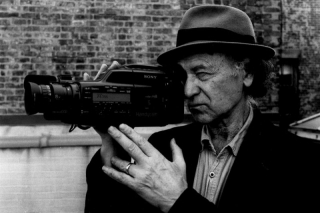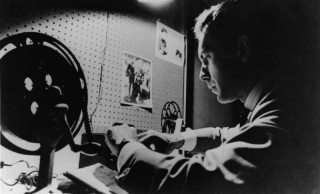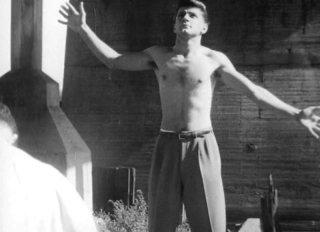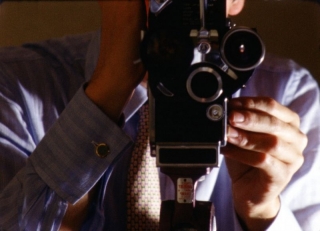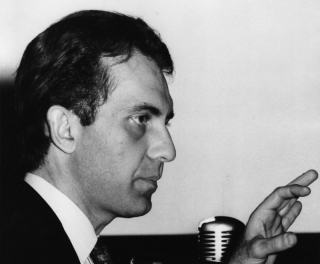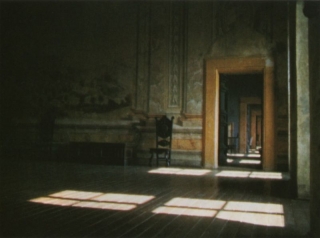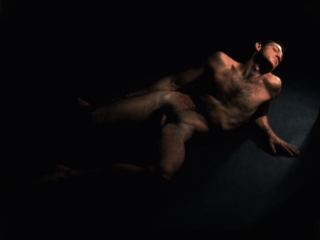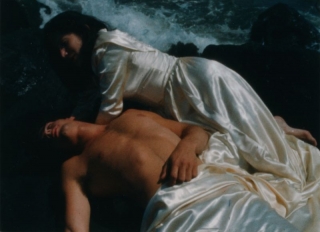Date: 5 January 2013 | Season: Jonas Mekas
BRIEF GLIMPSES OF BEAUTY: THE FILMS OF JONAS MEKAS (PART TWO)
5—26 January 2013
London BFI Southbank
‘I live, therefore I make films. I make films, therefore I live.’
The Lithuanian poet and filmmaker Jonas Mekas bought his first Bolex 16mm camera within weeks of arriving in the USA as a displaced person in 1949, and from that point onwards he carried it everywhere. Rather than pursuing conventional forms of cinema, he turned the camera towards his own life, recording brief bursts of images that condense his experiences in a unique diaristic style.
The first part of our season, in December 2012, featured Mekas’ earliest films and documented his first two decades in New York. During this time he was at the centre of the New American Cinema, fostering the exhibition, distribution and critical debate of a radical new film movement. In part two we follow the diaries from the early 1970s to the present day, and further programmes explore the collection of Anthology Film Archives, the film museum that Mekas established to showcase and preserve visionary cinema.
As Mekas became less intensely involved with organising the community of filmmakers, a romantic sensibility came to the fore in his work. Nature and family life become principle themes as he raises young children, and on journeys through the city or on trips abroad, he is often drawn to more bucolic subjects.
He began the shift from film to video in the 1980s, but it wasn’t until Letter from Greenpoint that he felt truly in control of the new medium. Shooting on digital enabled a more capacious style of filming, and led to an extraordinary period of productivity. For the 365 Day Project he transmitted dispatches from his new life in Brooklyn, uploading a new short film to his website every day throughout 2007, and in 2011 he completed no less than five feature-length works including the acclaimed Sleepless Nights Stories.
Jonas Mekas’ work is an ecstatic celebration of life, friendship and the arts. His camera and tape recorder have captured momentous cultural events, but also those precious moments which he refers to as ‘Miracles of the everyday – totally insignificant, but great!’
Curated by Mark Webber. With thanks to Jonas Mekas, Benn Northover, Serpentine Gallery and Centre Pompidou. The Jonas Mekas exhibition at Serpentine Gallery continues until 27 January. www.serpentinegallery.org
Date: 8 September 2014 | Season: Gregory Markopoulos: Film as Film | Tags: Gregory Markopoulos
GREGORY J. MARKOPOULOS: FILM AS FILM
8—13 September 2014
New York Anthology Film Archives
“There is no language. There is no art. There is no knowledge. There is but film as film: the beginning and the eternal moment.” (The Intuition Space, 1973)
Gregory J. Markopoulos (1928-92) is one of the most original filmmakers to emerge from the post-war avant-garde. His films, which often translated literary or mythological sources to a contemporary context, are celebrated for their extraordinary creativity, the sensuous use of color and innovations in cinematic form. A co-founder of the New American Cinema Group, Markopoulos was actively involved in nurturing New York’s film community before moving to Europe at the end of the 1960s to pursue a more individual path. Firmly believing that a filmmaker should be responsibility for all aspects of his work, he developed the idea of Temenos, a monographic archive for the preservation, presentation and study of his films.
In parallel to his filmmaking, Markopoulos was a prolific writer whose articles were circulated in journals, self-published editions or program notes. This screening series celebrates the publication of Film as Film: The Collected Writings of Gregory J. Markopoulos, a new book that gathers together some ninety out-of-print or previously unavailable texts by the filmmaker. See www.thevisiblepress.com for more information on the book, and for details of additional events at Light Industry, The Kitchen, Harvard Film Archive and elsewhere this fall.
This is an extremely rare opportunity to see Markopoulos’ earliest works, shown alongside some of the first films made in Europe following his departure from the US in 1967. Robert Beavers and Mark Webber (the editor of “Film as Film”) will be present and the book will be available for purchase at the programmes.
Date: 8 September 2014 | Season: Gregory Markopoulos: Film as Film | Tags: Gregory Markopoulos
GREGORY J. MARKOPOULOS: FILM AS FILM 1
Monday 8 September 2014, at 7:30pm
New York Anthology Film Archives
Made as a USC student in Los Angeles, Markopoulos’ first 16mm film Psyche took as its source the unfinished novella of the same name by Pierre Louÿs. Shown together with Lysis and Charmides (both made on his return to Toledo, Ohio, and inspired by Platonic dialogues), it forms the trilogy titled Du sang de la volupte et de la mort (1947-48). By boldly addressing lesbian and homosexual themes, the trilogy gained unwelcome notices in Films in Review and Variety where, in the repressive atmosphere of the early 1950s, it was branded “degenerate” following a screening at NYU. Such a response is unimaginable today for lyrical works that express sensuality through the symbolic use of color and composition. Writing about these early films, Markopoulos chose to quote a statement by philosopher and theologian Mircea Eliade, offering viewers a clue to his entire body of work: “The whole man is engaged when he listens to myths and legends; consciously or not, their message is always deciphered and absorbed in the end.”
Gregory J. Markopoulos, A Christmas Carol, 1940, 5 min
Gregory J. Markopoulos, Du Sang, de la volupté et de la mort, 1947-48, 70 min (Essential Cinema)
Gregory J. Markopoulos, Christmas USA, 1949, 8 min
“The first thing which I did was to delete the novelette of its lush rhetoric and retain only its symbolic color. In Psyche, color plays an important role, similar to the role which color plays in the paintings of Toulouse Lautrec. Color reflects the true character of the individual before us, whether it be on the screen, in a painting, or in the street. Color is Eros.” (Psyche’s Search for the Herb of Invulnerability, 1955)
Date: 11 September 2014 | Season: Gregory Markopoulos: Film as Film | Tags: Gregory Markopoulos
MARKOPOULOS/BEAVERS: EXPERIMENTAL FILMS/EXPERIMENTAL LIVES
Thursday 11 September 2014, at 7pm
New Haven Yale Whitney Humanities Center
Introduced and followed by a conversation with Mark Webber and Robert Beavers.
Gregory J. Markopoulos, Christmas USA, 1949, 8 min
Gregory J. Markopoulos, Through a Lens Brightly: Mark Turbyfill, 1967, 15 min
Robert Beavers, Early Monthly Segments, 1968-70/2000, 33 min
Gregory J. Markopoulos, Gilbert and George, 1970/1989-91, 12 min
Robert Beavers, Listening to the Space in My Room, 2010, 19 min
Presented by the Yale Film Studies Program, Hellenic Studies Program, Yale Film Colloquium, and Films at the Whitney.
PROGRAMME NOTES
MARKOPOULOS/BEAVERS: EXPERIMENTAL FILMS/EXPERIMENTAL LIVES
Thursday 11 September 2014, at 7pm
New Haven Yale Whitney Humanities Center
CHRISTMAS U.S.A.
Gregory J. Markopoulos, 1949, 16mm, 8 min
“The film is a subtly joyous depiction of sexual and sensual awakening – a celebration of a young man’s discovery of strange, exciting things lurking beyond the drab normality of the everyday. It’s a specific metaphor for Markopoulos’ homosexuality, of course, but also more generally for the sexual and intellectual awakenings of adolescence, the escape from the family to the individual life. That Markopoulos populates this moment with such wonder, passion, and mystical tension is a testament to his sure-handed ability to convey complex emotions cinematically, even at this early stage of his career.” (Ed Howard)
THROUGH A LENS BRIGHTLY: MARK TURBYFILL
Gregory J. Markopoulos, 1967, 16mm, colour, sound, 15 min
“One of the most accomplished works in Markopoulos’s series of film portraits, Through a Lens Brightly is a vivid study of the dancer and poet Mark Turbyfill that uses paintings and photographs in his home to recapture and illuminate a life in the arts.” (Harvard Film Archive)
EARLY MONTHLY SEGMENTS
Robert Beavers, 1968-70/2000, 35mm, colour, silent, 33 min
“Early Monthly Segments, filmed when Beavers was 18 and 19 years old, now forms the opening to his film cycle, “My Hand Outstretched to the Winged Distance and Sightless Measure.” It is a highly stylized work of self-portraiture, depicting filmmaker and companion Gregory J. Markopoulos in their Swiss apartment. The film functions as a diary, capturing aspects of home life with precise attention to detail, documenting the familiar with great love and transforming objects and ordinary personal effects into a highly charged work of homoeroticism.” (Susan Oxtoby)
GILBERT AND GEORGE
Gregory J. Markopoulos, 1970/1989-91, 16mm, colour, silent, 12 min
“Gregory Markopoulos’ Gilbert and George (1970) is a film marked by absence. Though a portrait of the artistic duo, the film indulges in none of the privileging of visibility on which the genre of portraiture often rests. Much of its twelve-minute duration is filled not with likenesses of the artists but with black and white leader. Occasionally a flash of image – a pair of feet, for example – will fill the screen for a brief moment before retreating again. The flow of movement, so crucial to most films, is missing. In its place is a rigorous engagement with the medium’s most basic elements, one that returns the viewer to the stillness of the individual film frame.” (Erika Balson)
LISTENING TO THE SPACE IN MY ROOM
Robert Beavers, 2010, 16mm, colour, sound, 19 min
“Ostensibly a portrait of a place where the artist had resided until recently, the film conjures not only the memory but also the physical presence of those who have previously stayed there. Adhering to a solitary intimacy while simultaneously acting as an ode to human endeavour and shared impulses toward fulfillment through art, Listening to the Space in my Room is a moving testament to existence (whose traces are found in literature, music, filmmaking, gardening) and our endless search for meaning and authenticity. The film’s precise yet enigmatic sound-image construction carries a rare emotional weight. ” (Andréa Picard)
Back to top
Date: 29 September 2014 | Season: Gregory Markopoulos: Film as Film | Tags: Gregory Markopoulos
GREGORY MARKOPOULOS: COLLECTED WRITINGS
Monday 29 September 2014, at 7pm
New York The Kitchen
Celebrating the publication of Film as Film: The Collected Writings of Gregory J. Markopoulos (The Visible Press), filmmaker Robert Beavers, scholar Daniel Heller-Roazen, and the volume’s editor Mark Webber will lead a discussion of Markopoulos’ unique vision of film and the film spectator. Following the discussion will be a very rare screening of one reel of his magnum opus, Eniaios. This publication contains some ninety out-of-print or previously unavailable articles by the Greek-American filmmaker (1928-1992) who, as a contemporary of Kenneth Anger, Stan Brakhage and Andy Warhol, was at the forefront of a movement that established a truly independent form of cinema. Beginning with his early writings on the American avant-garde and auteurs such as Dreyer, Bresson, and Mizoguchi, it also features numerous essays on Markopoulos’ own practice, and on films by Beavers, that were circulated only in journals, self-published editions, or program notes. The texts become increasingly metaphysical and poetic as the filmmaker pursued his ideal of Temenos, an archive and screening space to be located at a remote site in the Peloponnese where his epic, final work Eniaios could be viewed in harmony with the Greek landscape.
In the last decades of his life, working quietly in Europe, Markopoulos re-edited his whole body of earlier films and dozens of new ones into one magnum opus, Eniaios. It is one of the longest films ever made: the complete film lasts approximately 80 hours and is divided into 22 cycles. From the moment he began to construct it, it was Markopoulos’ intention that Eniaios be projected only at the open-air site of what he called “The Temenos,” in a field near the village of Lyssaraia, the birthplace of his father in the Peloponnese of mainland Greece. For Eniaios, the summa of his career, Markopoulos wished to create a deeply personal and utterly unique cinematic experience. He chose the site for its natural beauty; he had conceived the Temenos as a viewing space where the physical environment would be in harmony with his idea of cinema as an instrument of philosophical and psychological revelation. In calling his projection space “The Temenos,” the filmmaker was invoking the religious traditions of ancient Greece, where a portion of land was set aside for the ritual worship of a god. The original meaning of the term “Temenos” is “a piece of land set apart.” Markopoulos wanted his life work shown in a space “set apart,” when after years of working in the international arena of the experimental film, he grew disillusioned with the interrelated commercialism of the film industry, the universities, and the art museums. He was convinced that the grandeur of what he called “film as film” required something radically different.
Gregory Markopoulos: The Collected Writings is made possible with support from Axe-Houghton Foundation and Lambent Foundation Fund of Tides Foundation, and in part by public funds from New York City Department of Cultural Affairs in partnership with the City Council and New York State Council on the Arts with the support of Governor Andrew Cuomo and the New York State Legislature.
Date: 5 October 2014 | Season: Gregory Markopoulos: Film as Film | Tags: Gregory Markopoulos
FILM AS FILM: THE CINEMA OF GREGORY MARKOPOULOS 6
Sunday 5 October 2014, at 7pm
Cambridge Harvard Film Archive
Gregory J. Markopoulos, Hagiographia II, 1970/1989-91, 60 min
Past the gates of the Temenos, and upon the twin hills the film spectator of the future will encounter the immeasurable works of Beavers and Markopoulos. On one hill will be the space of Beavers. On another hill there will be the space of Markopoulos. Here the film spectator of the future will devote himself to eternity, to the works of Beavers, to the works of Markopoulos. The spectres of distribution will have been vanquished; the spectres of projection will have been vanquished; the spectres of printing will have been vanquished. The patron of the Temenos will be he who is also unknown; hewho is without gifts of any kind; he who will be as immortal as the works being presented; he who will recognize that of all the arts only film needs a space in which to be seen; the rest is all artificial: museums, theatres and such. Only in the heart of the Peloponnesus, in Pelop’s land will film culture survive enhanced by the spirit of a truly simple and free people; the Greeks. The Greece today maligned by the truly lesser powers will be the victor.”(Gregory J. Markopoulos, The Filmmaker’s Perception in Contemplation, 1972)
Date: 31 October 2014 | Season: Gregory Markopoulos: Film as Film | Tags: Gregory Markopoulos
GREGORY J. MARKOPOULOS: FILM AS FILM
Friday 31 October 2014, at 6:30pm
London Tate Modern
Gregory J. Markopoulos is a key figure in the history of independent film and was, alongside Kenneth Anger, Stan Brakhage, Maya Deren and Andy Warhol, a pioneer of the New American Cinema of the 1960s. This special evening celebrates the publication of Film as Film: The Collected Writings of Gregory J. Markopoulos, edited by Mark Webber, that gathers together for the first time the writings of this important filmmaker.
Gregory J. Markopoulos, Psyche, USA, 1947, 16mm, 25 min
Gregory J. Markopoulos, Bliss, Greece, 1967, 16mm, 6 min
Gregory J. Markopoulos, Gammelion, Italy, 1968, 16mm, 55 min
The evolution of Markopoulos’ filmmaking – from the early films of the 1940s to his increasingly poetic and metaphysical works made in Europe from the late 1960s onwards – is traced in his writings, which also address the avant-garde cinema, auteurs such as Dreyer, Bresson and Mizoguchi, and the work of his partner Robert Beavers. As Markopoulos pursued his ambitious plan to establish The Temenos, a screening space and archive devoted to his work that would be located in a remote part of Greece, his unique vision of a truly independent cinema was proposed through his texts and has inspired a diverse array of artists. Tacita Dean has celebrated the forthcoming publication stating, “it feels apposite that the writings of Gregory Markopoulos be published now at a time when the very existence of film is so threatened. Nothing more should be needed as a convincing argument that film is still the important, autogenic magical medium for filmmakers today.”
Following screenings of films by Gregory J. Markopoulos at Tate Modern in 2008, this evening will feature works not previously shown at Tate that illustrate key points in Markopoulos’ career interspersed with readings from the book. Made while studying at USC in Los Angeles, Psyche 1947, was his first 16mm film, and demonstrates Markopoulos’ developing style and his sensuous use of colour and composition. Shot in the Hollywood hills, the film was inspired by an unfinished novella by Pierre Louÿs, yet as Markopoulos described “the first thing which I did was to delete the novelette of its lush rhetoric and retain only its symbolic colour. In Psyche, colour plays an important role, similar to the role which colour plays in the paintings of Toulouse Lautrec. Colour reflects the true character of the individual before us, whether it be on the screen, in a painting, or in the street. Colour is Eros.” (Psyche’s Search for the Herb of Invulnerability, 1955).
Bliss 1967, the first film made after Markopoulos moved from the USA to Europe, is a lyrical study of the interior of the Byzantine Church of St. John on the island of Hydra. Using only available light and edited in camera, Bliss demonstrates the filmmaker’s aesthetic economy and rigour. Gammelion 1968, filmed at Il Castello Roccasinibalda in Rieti, Italy, is a major work in Markopoulos’s oeuvre, marking the transition into his late period and anticipating his epic final film, Eniaios 1947-91. Shot with only two rolls of film, the work extends seven minutes of footage to almost one hour of viewing time using hundreds of fades in and out. As lines of poetry, music, or the sound of horses’ hooves are heard on the soundtrack, images appear for only a few frames at a time, creating a remarkable romantic vision of a poetic cinema conjured from its essential components.
Curated by George Clark and Mark Webber. Introduced by Mark Webber and Robert Beavers.
Date: 20 November 2014 | Season: Gregory Markopoulos: Film as Film | Tags: Gregory Markopoulos
THE ILLIAC PASSION
Thursday 20 November 2014, at 8:30pm
Vienna Austrian Filmmuseum
In the presence of Robert Beavers
Gregory J. Markopoulos, The Illiac Passion, 1964-67, 91 min
Gregory J. Markopoulos, Rushes for The Illiac Passion, c.1965, 12 min
Gregory J. Markopoulos, Test with Masques for The Illiac Passion, 1966, 3 min
„Illiac” beschreibt das Auf- oder Erstellen einer Sache. Es ist ein anderer Name für poiesis, das Ursprungswort fürs Erschaffen, für das Filme-in-die-Welt-Setzen des „Filmemachers”. The Illiac Passion ist ein Film-als-Film-Kontinent und poetisch verschlüsseltes Selbstporträt, mit dem Markopoulos über sich als einen anderen (namens Prometheus) und über die Leidenschaften des Erzeugens von Werken (also auch von Filmen, also auch über die passions von Illiac Passion) erzählt. The Illiac Passion ist ein Mythen-Irrgarten, beglänzt vom Licht des Sterns Farbe-ist-Eros. Film, in dem Griechenlands Götter sich nach Manhattan begeben und in dem das Erhabene und Gewöhnliche nicht müde werden, einen tollkühnen, tragischen, magischen Tanz aus flackernden single frames, Doppelbelichtungen, Metaphern und schierer Bildpracht zu tanzen: die Summe der maßlosen wie maßvollen Markopoulos-Filmschrift. (Harry Tomicek)
Date: 24 November 2014 | Season: Gregory Markopoulos: Film as Film | Tags: Gregory Markopoulos
EARLY WORK
Monday 24 November 2014, at 6pm
Vienna Austrian Filmmuseum
In the presence of Robert Beavers
Gregory J. Markopoulos, A Christmas Carol, 1940, 5 min
Gregory J. Markopoulos, Christmas USA, 1949, 13 min
Gregory J. Markopoulos, The Dead Ones, 1949, 29 min
Gregory J. Markopoulos, Flowers of Asphalt, 1949-51, 7 min
Gregory J. Markopoulos & Robert C. Freeman, Swain, 1950, 20 min
Seinen ersten Film A Christmas Carol dreht er im Alter von zwölf. Mit The Dead Onesund Flowers of Asphalt begibt er sich auf die Spuren Cocteaus. Er liebt Stroheim, studiert bei Sternberg und schreibt, Jahre später, eine huldigende Botschaft an D.W. Griffith, seinen Wahlverwandten. Er glaubt jedoch, dass im Tonfilm der Ton das Bild zu ersticken droht und der Ton selbst nur der naturalistische Schatten des Bildes ist. Sein Traum von der Errettung des Bildes und Befreiung des Tons im Film lässt ihn ein Film-Universum aus Einzelbildern und Tonauslöschungen entwerfen. „Meine Liebe zum Film ist stärker als jede Moral.” Er ist ein Einsamer und einer der Wenigen. Er ist einer der free radicals des Films. (Harry Tomicek)
Date: 6 January 2015 | Season: Gregory Markopoulos: Film as Film | Tags: Gregory Markopoulos
MARKOPOULOS/BEAVERS: FILM AS FILM
Tuesday 6 January 2015, at 7:15pm
Amsterdam EYE Filmmuseum
Gregory Markopoulos’ status as a leading figure of avant-garde cinema was affirmed by Twice a Man. This homoerotic adaptation of the myth of Hippolytus, set in 1960s New York, employs a radical editing style that integrates single-frame ‘though-images’ within its larger narrative. Five years later, Markopoulos and his partner Robert Beavers, left the US for Europe to pursue filmmaking in relative isolation. Beavers established a regular practice of filming in order to explore the potential of the 16mm camera. Early Monthly Segments is the result of this experimentation – an exhilarating process of discovery that also documents the daily lives of both filmmakers. By the 1980s, Markopoulos had begun to regard the Greek landscape as the ideal environment in which his work should be viewed. Daniël Singelenberg’s Temenos is a rare document of one of the annual presentations of ‘film as film’ at a remote site in the Arcadian countryside.
Gregory J. Markopoulos, Twice a Man, 1963, 46 min
Robert Beavers, Early Monthly Segments, 1968-70/2002, 33 min
Daniël Singelenberg, Temenos, 1982, 12 min
Introduced by Mark Webber.
PROGRAMME NOTES
MARKOPOULOS/BEAVERS: FILM AS FILM
Tuesday 6 January 2015, at 7:15pm
Amsterdam EYE Filmmuseum
TWICE A MAN
Gregory J. Markopoulos, USA, 1963, 16mm, colour, sound, 49 min
Twice A Man is a fragmented re-imagining of the Greek myth of Hippolytus, who was killed after rejecting the advances of his stepmother. Markopoulos’ vision transposes the legend to 1960s New York and has its main character abandon his mother for an elder man. Employing sumptuous colour, the film radicalised narrative construction with its mosaic of ‘thought images’ that shift tenses and compress time. One of the touchstones of independent filmmaking, Twice A Man was made in the same remarkable milieu as Scorpio Rising and Flaming Creatures by a filmmaker named ‘the American avant-garde cinema’s supreme erotic poet’ by its key critic P. Adams Sitney.
EARLY MONTHLY SEGMENTS
Robert Beavers, USA, 1968-70/2002, 35mm, colour, silent, 33 min
“Early Monthly Segments, filmed when Beavers was 18 and 19 years old, now forms the opening to his film cycle, My Hand Outstretched to the Winged Distance and Sightless Measure. It is a highly stylized work of self-portraiture, depicting the filmmaker and his companion Gregory J. Markopoulos. The film functions as a diary, capturing aspects of home life with precise attention to detail, documenting the familiar with great love and transforming objects and ordinary personal effects into a highly charged work of homoeroticism.” (Susan Oxtoby, Toronto International Film Festival).
TEMENOS
Daniël Singelenberg, Greece, 1982, 16mm, colour, silent, 12 min
Dutch filmmaker and writer Daniël Singelenberg travelled to Greece for the early Temenos screenings. His personal documentary of the 1982 festival of Film as Film in Arcadia shows the preparation of the screening space and the idyllic landscape that surrounds it, and is one of the very few documents of Markopoulos and this unique event.
Back to top
